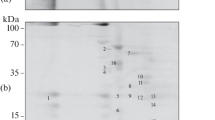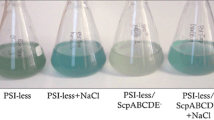Abstract
Small heat-shock proteins are molecular chaperones that bind and prevent aggregation of nonnative proteins. They also associate with membranes. In this study, we show that the small heat-shock protein HspA plays a protective role under oxidative stress in the cyanobacterium Synechococcus elongatus strain ECT16-1, which constitutively expresses HspA. Compared with the reference strain ECT, ECT16-1 showed much better growth and viability in the presence of hydrogen peroxide. Under the peroxide stress, pigments in thylakoid membrane, chlorophyll, carotenoids, and phycocyanins, were continuously reduced in ECT, but in ECT16-1 they decreased only during the first 24 h of stress; thereafter no further reduction was observed. For comparison, we analyzed a wild type and an hspA deletion strain from Synechocystis sp. PCC 6803 and found that lack of hspA significantly affected the viability of the cell and the pigment content in the presence of methyl viologen, suggesting that HspA stabilizes membrane proteins such as the photosystems and phycobilisomes from oxidative damage. In vitro pull down assays showed a direct interaction of HspA with components of phycobilisomes. These results show that HspA and small heat-shock proteins in general play an important role in the acclimation to oxidative stress in cyanobacteria.






Similar content being viewed by others
References
Adir N (2005) Elucidation of the molecular structures of components of the phycobilisome: reconstructing a giant. Photosyn Res 85:15–32
Allen SP, Polazzi JO, Gierse JK, Easton AM (1992) Two novel heat-shock genes encoding proteins produced in response to heterologous protein expression in Escherichia coli. J Bacteriol 174:6938–6947
Asada K (2006) Production and scavenging of reactive oxygen species in chloroplasts and their functions. Plant Physiol 141:391–396
Asadulghani, Nitta K, Kaneko Y, Kojima K, Fukuzawa H, Kosaka H, Nakamoto H (2004) Comparative analysis of the hspA mutant, wild-type Synechocystis sp. strain PCC 6803 under salt stress: evaluation of the role of hspA in salt-stress management. Arch Microbiol 182(6):487–497
Bus JS, Gibson JE (1984) Paraquat: model for oxidant-initiated toxicity. Environ Health Perspect 55:37–46
Haslbeck M, Franzmann T, Weinfurtner D, Buchner J (2005) Some like it hot: the structure and function of small heat-shock proteins. Nat Struct Mol Biol 12:842–846
Hihara Y, Sonoike K (2001) Regulation, inhibition and protection of photosystem I. In: Aro EM, Andersson B (eds) Advances in photosynthesis and respiration. Vol.11. Regulation of photosynthesis. Kluwer Academic, Dordrecht, pp 507–531
Horváth I, Glatz A, Varvasovszki V, Török Z, Páli T, Balogh G, Kovács E, Nádasdi L, Benkö S, Joó F, Vígh L (1998) Membrane physical state controls the signaling mechanism of the heat-shock response in Synechocystis PCC 6803: identification of hsp17 as a “fluidity gene”. Proc Natl Acad Sci USA 95:3513–3518
Kappé G, Leunissen JA, de Jong WW (2002) Evolution and diversity of prokaryotic small heat-shock proteins. Prog Mol Subcell Biol 28:1–17
Kitagawa M, Matsumura Y, Tsuchido T (2000) Small heat-shock proteins, IbpA and IbpB, are involved in resistances to heat and superoxide stresses in Escherichia coli. FEMS Microbiol Lett 184:165–171
Kojima K, Suzuki-Maenaka T, Kikuchi T, Nakamoto H (2006) Roles of the cyanobacterial isiABC operon in protection from oxidative and heat stresses. Physiol Plant 128:507–519
Liu XG, Zhao JJ, Wu QY (2005) Oxidative stress and metal ions effects on the cores of phycobilisomes in Synechocystis sp. PCC 6803. FEBS Lett 579:4571–4576
Li H, Singh AK, McIntyre LM, Sherman LA (2004) Differential gene expression in response to hydrogen peroxide and the putative PerR regulon of Synechocystis sp. strain PCC 6803. J Bacteriol 186:3331–3345
MacColl R (1998) Cyanobacterial phycobilisomes. J Struct Biol 124:311–334
Matuszewska E, Kwiatkowska J, Kuczynska-Wisnik D, Laskowska E (2008) Escherichia coli heat-shock proteins IbpA/B are involved in resistance to oxidative stress induced by copper. Microbiology 154:1739–1747
Murata N, Takahashi S, Nishiyama Y, Allakhverdiev SI (2007) Photoinhibition of photosystem II under environmental stress. Biochim Biophys Acta 1767:414–421
Nakamoto H, Honma D (2006) Interaction of a small heat-shock protein with light-harvesting cyanobacterial phycocyanins under stress conditions. FEBS Lett 580:3029–3034
Nakamoto H, Vígh L (2007) The small heat-shock proteins and their clients. Cell Mol Life Sci 64:294–306
Nakamoto H, Suzuki N, Roy SK (2000) Constitutive expression of a small heat-shock protein confers cellular thermotolerance and thermal protection to the photosynthetic apparatus in cyanobacteria. FEBS Lett 483:169–174
Nelson N, Yocum CF (2006) Structure and function of photosystems I and II. Annu Rev Plant Biol 57:521–565
Nitta K, Suzuki N, Honma D, Kaneko Y, Nakamoto H (2005) Ultrastructural stability under high temperature or intensive light stress conferred by a small heat-shock protein in cyanobacteria. FEBS Lett 579:1235–1242
Raps S (1990) Differentiation between phycobiliprotein and colorless linker polypeptides by fluorescence in the presence of ZnSO4. Plant Physiol 92:358–362
Roy SK, Hiyama T, Nakamoto H (1999) Purification and characterization of the 16 kDa heat-shock-responsive protein from the thermophilic cyanobacterium Synechococcus vulcanus, which is an alpha-crystallin related, small heat-shock protein. Eur J Biochem 262:406–416
Sidler WA (1994) Phycobilisome and phycobiliprotein structure. In: Bryant DA (ed) The molecular biology of cyanobacteria. Kluwer Academic, Dordrecht, pp 139–216
Telfer A, Bishop SM, Phillips D, Barber J (1994) Isolated photosynthetic reaction center of photosystem II as a sensitizer for the formation of singlet oxygen: detection and quantum yield determination using a chemical trapping technique. J Biol Chem 269:13244–13253
Török Z, Goloubinoff P, Horváth I, Tsvetkova NM, Glatz A, Balogh G, Varvasovszki V, Los DA, Vierling E, Crowe JH, Vigh L (2001) Synechocystis HSP17 is an amphitropic protein that stabilizes heat-stressed membranes and binds denatured proteins for subsequent chaperone-mediated refolding. Proc Natl Acad Sci USA 98:3098–3103
Van Montfort R, Slingsby C, Vierling E (2001) Structure and function of the small heat-shock protein/alpha-crystallin family of molecular chaperones. Adv Protein Chem 59:105–156
Veinger L, Diamant S, Buchner J, Goloubinoff P (1998) The small heat-shock protein IbpB from Escherichia coli stabilizes stress-denatured proteins for subsequent refolding by a multichaperone network. J Biol Chem 273:11032–11037
Yamanaka G, Glazer AN, Williams RC (1978) Cyanobacterial phycobilisomes: characterization of the phycobilisomes of Synechococcus sp. 6301. J Biol Chem 253:8303–8310
Acknowledgment
K. S. was a recipient of a Japanese government scholarship for study in Japan.
Author information
Authors and Affiliations
Corresponding author
Additional information
Communicated by Mary Allen.
Electronic supplementary material
Below is the link to the electronic supplementary material.
203_2009_457_MOESM1_ESM.tif
Supplementary Fig. 1. Cell growth (a), viability (b), and cellular absorption spectra of the Synechococcus ECT (c) and ECT16-1 (d) strains incubated in the presence of 0.8 mM hydrogen peroxide for 0, 24, 48, and 72 h. Diamonds and squares (a and b) represent ECT and ECT16-1, respectively. Cells were cultured at 30oC to approximately 0.3 apparent absorbance at 730 nm, and then (at 0 h) hydrogen peroxide was added to a final concentration of 0.8 mM (TIFF 8496 kb)
203_2009_457_MOESM2_ESM.tif
Supplementary Fig. 2. Cell growth (a), viability (b), and cellular absorption spectra of the Synechococcus ECT (c) and ECT16-1 (d) strains incubated in the presence of 0.9 mM hydrogen peroxide for 0, 24, 48, and 72 h. Diamonds and squares (a and b) represent ECT and ECT16-1, respectively. Cells were cultured at 30oC to approximately 0.3 apparent absorbance at 730 nm, and then (at 0 h) hydrogen peroxide was added to a final concentration of 0.9 mM (TIFF 8496 kb)
Rights and permissions
About this article
Cite this article
Sakthivel, K., Watanabe, T. & Nakamoto, H. A small heat-shock protein confers stress tolerance and stabilizes thylakoid membrane proteins in cyanobacteria under oxidative stress. Arch Microbiol 191, 319–328 (2009). https://doi.org/10.1007/s00203-009-0457-z
Received:
Revised:
Accepted:
Published:
Issue Date:
DOI: https://doi.org/10.1007/s00203-009-0457-z




